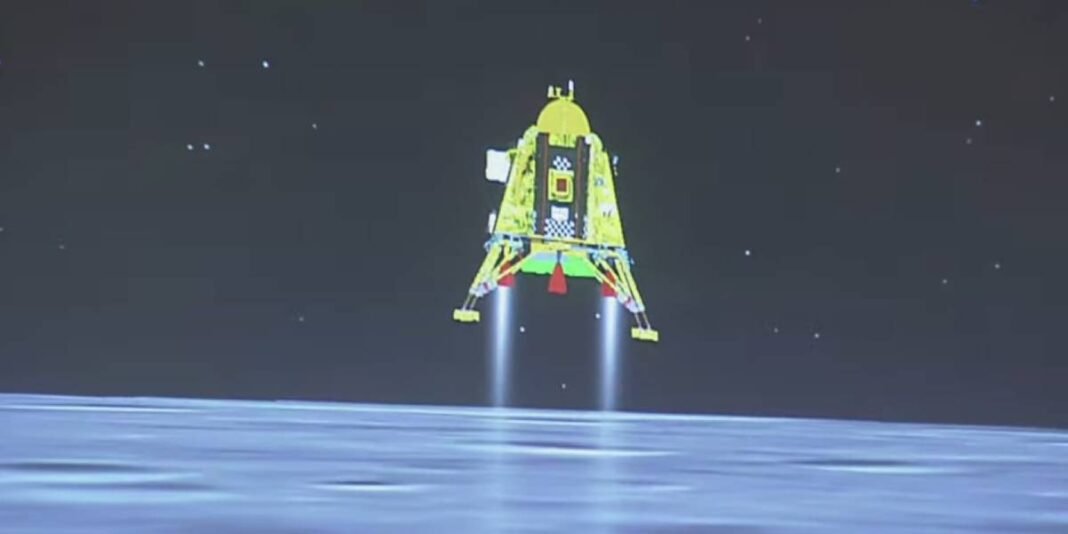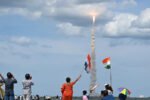By: Dipak Kurmi
On the notable date of August 23, 2023, India etched its name onto the celestial canvas, orchestrating a masterful achievement that graced the lunar stage. A captivating ballet unfolded as the Chan Lander, a sentient spacecraft, descended with grace and finesse to finally cradle itself upon the Moon’s southern polar embrace, a region poetically known as “lunar’s heart.” The mission’s purpose is to unravel the Moon’s enigmas, peering into its very essence, deciphering its secretive compositions and the elusive breath of its atmosphere, which barely dares to stir. In the entourage of this triumph, the Pragyan rover, a six-wheeled wanderer, once nestled within Vikran’s embrace now breathes the lunar air. With meticulous steps, it embarks on a voyage of discovery, tracing careful lines across the untouched tapestry of the landing site.
The propulsion module of Chandrayan, responsible for ferrying Vikram from Earth to a lunar orbit 150 km above, remains in orbital motion around the Moon. Accompanying it is Chandrayaan-2’s orbital module, which has encircled the Moon for the past four years, transmitting extensive data about the lunar realm in all its dimensions. Simultaneously observing an Indian lander and rover stationed on the lunar terrain, along with two of our spacecraft in lunar orbit, is an extraordinary stroke of luck. This outcome is a direct consequence of the scrupulous planning, unwavering determination, and wholehearted commitment demonstrated by the countless members comprising India’s esteemed space community, who understandably revel in this moment of triumph.
The task of landing on the airless expanse of the lunar surface remains undeniably challenging. This achievement has been realized by only four nations thus far: the former USSR/Russia, the United States, China, and now India. Of particular significance to India is the achievement of a delicate touchdown by Chandrayaan in the Moon’s southern polar region, distinguished by its intricate yet captivating landscape. Scientists are deeply intrigued by the potential presence of water ice in this area, alongside remnants from the early solar system, both of which serve as compelling incentives. These factors have collectively rendered the lunar South Polar Region a prime objective for space missions from countries such as India, the United States, Russia, China, and Japan.
In the days preceding Chandrayaan’s gentle lunar landing, discussions arose regarding a potential race between Russia and India to reach the southern pole of the Moon. However, India’s pursuit of achieving a soft landing in this specific region dates back to the Chandrayaan-2 mission, which unfortunately fell short of completing this objective. Meanwhile, Russia has its distinct motivations for reengaging in lunar exploration, marking a return after a hiatus of 47 years.
A meticulous examination of Chandrayaan-3, with a weight of 3,500 kg, unveils a journey spanning approximately 40 days to its designated destination. This journey showcases the remarkable precision that characterized each planned event, commencing from its launch propelled by our indigenous LVM3 vehicle. The sequence seamlessly progresses to its alignment with the trajectory intersecting the Moon, followed by its successful integration into lunar orbit, subsequent separation, and the flawless landing of Vikram. Moreover, this narrative underscores both the analytical prowess and adept management of ISRO, exemplifying its capacity to excel in challenging circumstances.
With Chandrayaan-2 having effectively executed all these manoeuvres except for the delicate landing, it was the act of landing itself that held the attention of millions of Indians in suspense. Engaging in any spacecraft operation of this nature tends to evoke a mixture of nerves and excitement among those deeply committed to its success. As the real-time transmission captured the initiation of the ‘retro burn,’ involving the activation of the four rocket engines on Chandrayaan-3’s Vikram Lander, people across India and around the globe collectively held their breath in anticipation.
Despite the insights gained from Chandrayaan-2 and the extensive measures taken, including design enhancements and the implementation of backup systems, ISRO scientists remained cautious about the landing endeavour. Nonetheless, their unwavering commitment and relentless efforts yielded remarkable results. This dedication bore fruit when Vikram achieved a flawless touchdown within the targeted southern polar expanse of the lunar terrain.
Upon confirming the operational status of the solar-powered Vikram Lander and its accompanying Pragyan rover, the directive was given for the rover’s descent. Carrying out its task with fidelity, Pragyan smoothly descended by gliding down an extended ramp. As Pragyan initiated its traversal across the untouched southern polar landscape, its wheel imprints etched enduring impressions of the national emblem and ISRO logo onto the lunar surface. With this accomplishment, a significant portion of Chandrayaan-3’s objectives had been fulfilled.
Having effectively showcased the vital indigenous technologies required for lunar landing and rover operations, ISRO will now shift its attention towards on-site exploration. This will be facilitated through the utilization of the three scientific payloads housed within Vikram, as well as the two within Pragyan. This phase is slated to span the upcoming 14 Earth days, a duration coinciding with continuous solar illumination upon the landing site due to the Sun’s presence. This lighting will directly illuminate the solar panels of both Vikram and Pragyan. Historically, ISRO’s lunar study was restricted to remote sensing methods, but the current achievement marks a pivotal transition toward on-the-ground exploration.
Vikram comprises three payloads: RAMBHA, L.P. ChaSTE, and ILSA, each tasked with investigating distinct lunar facets. RAMBHA aims to analyze the Moon’s sparse atmosphere’s density and fluctuations. L.P. ChaSTE will delve into the thermal conductivity properties of the lunar surface. ILSA, on the other hand, will harness lunar seismic activity to unveil insights into the Moon’s internal makeup. Pragyan, equipped with two spectrometers, will play a pivotal role in unravelling the chemical, mineralogical, and elemental composition of the lunar surface.
Historically, the Moon has served humanity by aiding maritime navigation and timekeeping. In the modern era of space exploration, it assumes a pivotal role in comprehending Earth and the solar system’s evolutionary journey. Its allure extends beyond valuable water, minerals, and fuel resources; the Moon could potentially serve as a launch pad for crewed ventures into distant realms. Chandrayana’s triumph will undeniably establish a robust groundwork for India’s forthcoming ambitious pursuits.







